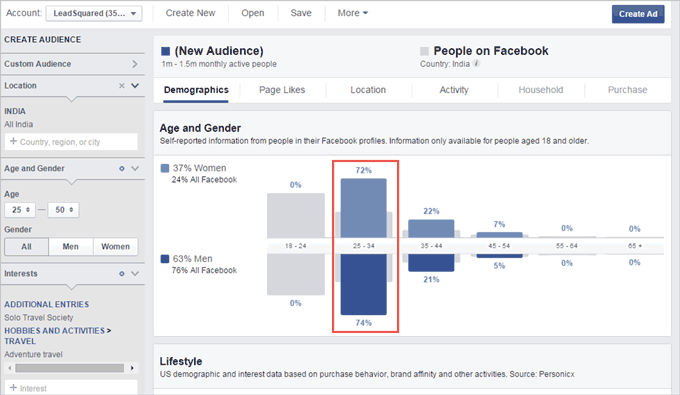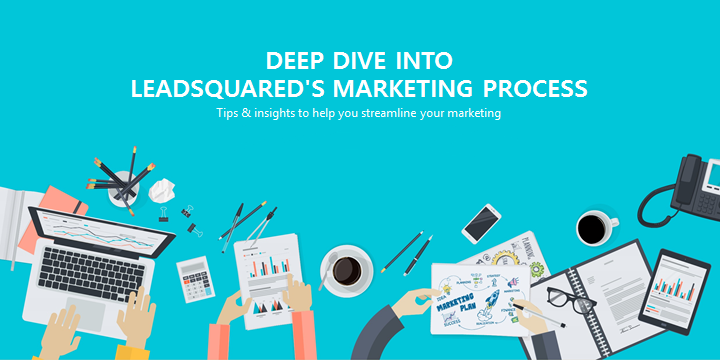Last Friday, we discussed our marketing strategy here at LeadSquared. The session covered everything from the kind of campaigns that we run, the metrics we use to measure success, how we hire new members for the team, and learnings from having tried different marketing channels, and formats over the course of past 3 years. In case, you missed the recording, here it is.
Here are the questions that came in during the session, along with Nilesh’s answers to them.
Marketing Strategy
1. How have you distributed your marketing budget to various channels? What percentage to each channel and how do you decide on it?
We always do the allocation based on our historical data, and cost averages. Let me explain.
The most important success metric that helps us do the allocation is revenue. Right from the beginning of the campaign, we try to tweak it to get the best quality leads. So, based on where the best leads are coming from (in terms of revenue), we allocate budgets. When we come across a new lead source, it’s less about allocation, but more about what are we willing to pay for a lead.
I know the average cost of a demo, cost of a customer, and the lead to customer ratio for different channels. So, if a new channel comes up, and the cost is comparable, I would go for it. Even if the cost is a little bit higher (say 2x), but the frequency of the leads is 2x as well, I would still go for this channel, when I have the money, and I am trying to speed up the acquisition.
2. Does each SAAS company figure out its right marketing strategy by experimentation over a period of time or is there a broad right approach that can be followed if they get the right resource or mentors to guide them?
I think everyone eventually learns from experimentation and experience, even if they have the right resources and mentors guiding them.
3. How can we use Social Media Platforms in a chain formation to acquire leads ?
Before you decide to invest on a particular social media platform, you should find out if your audience is there on not. All the social channels will tell you what kind of impressions can you get, if you specify your audience criteria. For instance, this is Facebook’s audience insights:

Then, once you figure out the correct channels, you should figure out the actual marketing strategy – the appeal, offer and creatives that would work on the channel. This would differ based on different channels. Eventually, you should invest only on channels, where you are able to get high quality leads, unless the aim of your campaign is visibility. Don’t invest on a channel just because others are doing it.
On that note, here’s a post about successful LinkedIn ads, and we have a new webinar coming up on social selling, which you might want to attend.
Conversion Rate Optimization
4. How often should a landing page be changed?
As soon as you start seeing a downwards trend, you should change the landing page. The frequency changes with the channel. In Facebook, you would generally start seeing lower impressions within a week or two. Then, you know that it’s time to change the creatives. Landing Page you shouldn’t change if the conversion rate is still good.
5. How can we generate leads from E-books and whitepapers?
You’ll have to gate your e-books behind a lead capture landing page.
6. What is a Good Website Visit / Leads Ratio and Leads to Customer Ratio?
It depends on a lot of things – channels (PPC’s conversion would differ from direct traffic etc.), what industry you are in, your products and the offers. A good number would be north of 5% (website to lead). Leads to customer would vary from product to product. A mid single digit percentage would be a good number for lead to customer.
7. Most people believe that A/B testing is something risky, what do you suggest?
It’s not risky. In fact it’s very important. It’s something that people should do. However, people should learn to do “A” first, before you move on to A/B.
Content Marketing
8. What is an ideal registration count for a webinar. The company in question is only local.
We see a lot of difference based on the topic selected. For instance, a complex or widely popular topic like Google Adwords can get us as many as 700-800 registrations, whereas a business-specific topic (ROI, revenue etc.) would get us 250 registrations. However, the quality of leads would be better in case of business-specific topics. After 3 years of conducting webinars, we have realized that while topics like SEO might generate a lot of interest, but actual customer conversions come from business-centric topics.
9. How does LeadSquared receive reviews on the review websites? Are you using any system for the review management? And how to receive reviews on multiple websites?
We aren’t using any system as such. Some happy customers review us on their own. However, from time to time we run campaigns requesting them to write reviews (we don’t try to get them to write good reviews – just their actual experience), in exchange for a reward. This works well. Ask the sales person with a good client relationship to do this.
It’s hard to get reviews on multiple websites because of the number of steps associated with the process. However, separate rewards for separate platforms can be one motivation.
10. If we talk about marketing through Blog, how do you define that a topic is simple or not since audience is too diverse?
We decide this based on historic data. As in what posts have worked well in the past – just analyzing past trends is a very good way.
Marketing Team
11. What is one thing you would like to change in your Marketing Team in the short run?
I would like all my people to become storytellers.
12. If given a chance, whom would you hire – An IIM-A guy or a guy with experience working with your competitor?
This is a very subjective question. We have a 5-step procedure of hiring people, including different kinds of tests and interviews. So, we would hire the person who outperforms the other, irrespective of their past experience. If there’s some talent out there with a competitor who would fit well with our marketing team, why not! But, they have to do well in our internal hiring process as well, because we try to test a lot of things, and have done a good job of hiring people in the past with this procedure.
Marketing Metrics
13. Whats is the amount of time a marketing team should spend in actual marketing vs marketing analytics?
Analysis is very important, but more important is executing the plan based on what you analyze. We do a weekly/monthly marketing analysis meeting, and planning based on that. But, execution is always more important.
14. Is Cost per Lead directly proportional to cost per Trial & Demo?
Let’s say you are spending X amount on paid channels. and 2 people in your marketing team take care of that. So, the total cost per lead would be ad cost + people cost. If you are doing outbound, then again cost would be divided among the salaries of the people (here you generally get a demo directly).
In case a lead comes through inbound, takes a trial and converts on its own – you don’t really have the cost of demo involved here. When you have to call them for a trial, or a demo, then cost of this call would be taken into account as well. Generally, cost per demo would be much higher than cost per lead. If all the teams are involved in the closure, then it would be directly proportional, but sometimes, it would be independent.
15. In outbound marketing – What are the metrics we should focus on to measure calling team’s performance in converting lead to prospects?
From an outbound standpoint, you have to set the expectations/outcome first. If you are selling different products – differing in ticket size, the cost of acquisition would be similar for low cost and high cost items. So, it makes sense to aim at high ticket items with outbound, because the return on investment is more. So, you should judge your outbound people on whether they are able to identify and convert these bigger ticket size leads.
Many managers judge their pre-sales teams based on the number of calls. Personally, I don’t care about that, as long as I am getting the outcome. If the outcome is not enough, then I probably would.
Google Adwords
16. In Adwords, when you say increasing quality of leads, do you remove the keywords ?
We mark negative keywords almost on daily basis, so that the quality of impressions is high.
17. You said you measure Lead Quality Score. So you go that deep with each keyword, and their lead score?
Lead Quality Score is a metric within LeadSquared that helps us assess the quality of the leads that come in. So, we look at that metric, and determine that a particular lead from a particular ad group is better than one from another ad group. It helps us assess the performance of ad groups based on lead quality.
If you are talking about Quality Score of the keyword, that has a lot of metrics to consider. These two are the most important ones.
a) search term + ad copy relevance (determined by CTR)
b) ad copy + landing page match (determined by the conversion rate)
Sales Techniques
18. What is your thought on Feet on street sales model for a product like yours in India, have you tried it and what has been your experience ?
If you are selling to shopkeepers/merchants, you don’t really have to take an appointment. You just need to gate-crash. This is classic feet-on-street. However, if you are selling to businesses with marketing and sales teams (like us), you cannot really do this. First you need to set an appointment and then go meet people.
19. On outbound campaigns that your sales development team carries out, what process do you follow? Is it through cold calls or email or both and how do you even build a list of leads to pursue them?
Buy, create – both options are there. Buying is something we are wary of (many junk leads would be there).
Our sales team does both – cold calls, and emails. The content you use to reach out is the key. The emails should not be generic, or impersonal. Always make the outbound email worth the person’s time.
LeadSquared Mobile App
20. When did LeadSquared decide to have a mobile application ? And why wasn’t e-mail added into it?
Mobile app was always a part of the plan, because we are trying to make sales persons’ life easy. We didn’t add email, because the app is primarily meant for the sales team. They are not people who would be running a lot of email campaigns when travelling for meetings – that’s why we have left it out. However, if a lot of clients see value in the feature, we might think about adding it to the app.









